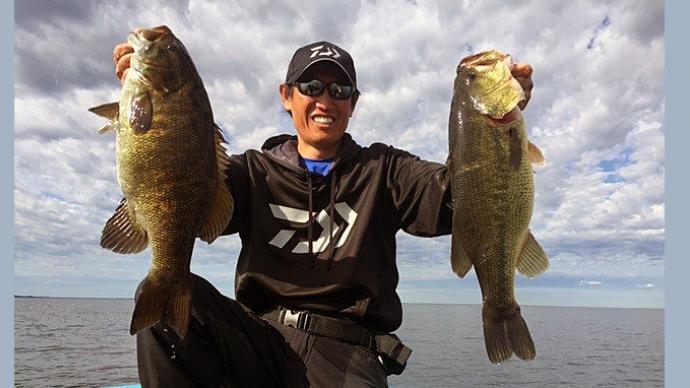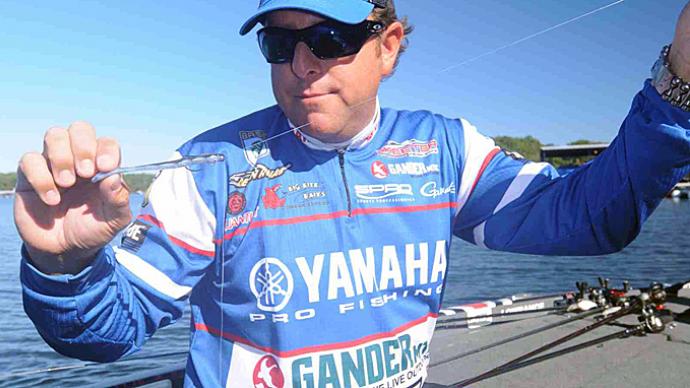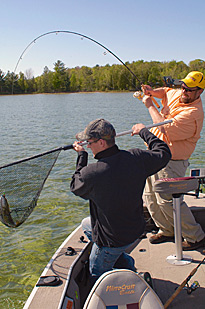
If you’re a smallmouth bass fanatic and have not mastered drop-shotting, you’d better take a crash course. Drop shotting has become the go-to technique for smallmouth bass fishing.
“How much I drop shot depends on the season,” offered tournament pro and smallmouth aficionado Scott Dobson. “In the summer, I probably drop shot 70% of the time. If I’m offshore and fishing vertically, it’s 100%. Same with sight fishing. If I’m sight fishing, I’m drop shotting. Drop shotting is a finesse technique used when you’re fishing the bottom and locked on fish. Would I rather be power fishing? Absolutely! But drop-shotting is so effective when you know there are fish down there.”
A big part of drop-shotting is having the right equipment.
“When it comes to line, I try to use as heavy a fluorocarbon as I can get away with,” Dobson said. “Typically, that’s 10- or 12-pound test. Any heavier than that impedes the lure’s action, I think. I’ve seen it in extremely clear water situations where the weight of the line can make a difference. I know fluorocarbon is supposed to have the same refractory qualities as water, so it’s invisible, but I’ve watched bass come up to a lure, look at it and turn and swim away. I’m not sure if there’s a shadow or a silhouette from the line, but I’ve watched bass in places with extremely clear water, like the Thousand Islands, swim right up to your drop shot bait, look at it and then turn and swim away. When I dropped down to 8-pound, I got a few to bite. I didn’t have any 6-pound fluorocarbon, or I probably would have gotten even more bites.”
Dobson firmly believes in using braid as a mainline when drop shotting. “I use 10/4 Suffix 832 braid all the time,” he said. “I’ve had good luck with that line, it’s tough, and I can usually get an entire season out of it. Usually, I turn it over, dry it out at some point in the year, and I’m good to go.”
The leader is critical when drop shotting. Spending a little extra on leader material is money well spent. “I’ve used Seaguar Tatsu 100% of the time,” claimed Dobson. “It’s tough, has great castability, and is amazingly strong yet subtle. It’s not cheap, but since I’m just using it for leader material, a 200-yard spool will last me all season.”
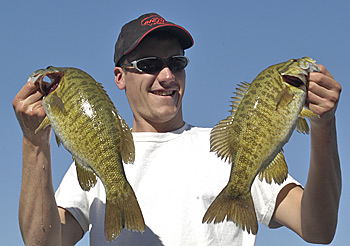
Rod choice when drop shotting depends on whether you’re fishing vertically or casting some distance. “For vertical fishing, I like a 6’ 9” to 7-foot medium/light action rod, like Dobyn’s SA702SF. If I’m casting longer distances, I prefer a 7’ 4” rod, like Dobyn’s DX742SF. You don’t need a heavy rod for drop-shotting because you don’t set the hook. You just let the rod load and reel until the line comes tight, like when using a circle hook.”
“When it comes to hooks, I use Gamakatsu's Split Shot/Drop Shot Hooks 100% of the time,” claimed Dobson. “It’s the ultimate hook for using any number of soft plastics for drop shotting. It has the ideal shape and shaft length. Depending on the bait I'm fishing, I’ll use either a 1/0 or size 1.”
A new drop shot hook on the market worth trying is called a Zoneloc. The chemically sharpened octopus hook’s unique shape claims to hook bass better and keep them pinned on when drop-shotting.
The weight might not seem important when drop shotting, but it is. “I prefer a cylindrical tungsten weight when drop-shotting because you seem to have a better sense of feel with tungsten,” offered Dobson. “The density of tungsten transmits every little bump in the bottom, giving you a tremendous sense of feel. How heavy a weight you use depends on the bottom contours, wind, and depth, but I generally find a ¼- or 3/8-ounce weight work well.
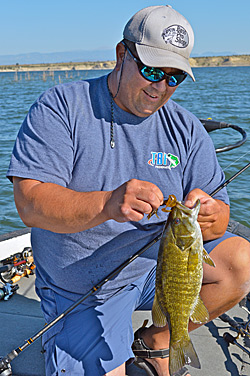
“Occasionally, if the current is strong or I’m fishing deep water, I’ll go to a ½ ounce. If you lose a weight, it's more often because a fish threw it rather than losing it on a snag. There’s a slot in the top of the weight your line slides into, and it’s easy for a jumping fish to whip it around and break it off. The tungsten weights are more expensive, but I think they’re worth it.”
The length of the leader between the weight and the lure is generally between 12 inches and two feet. “Leader length depends on whether I’m casting or fishing vertically, the depth of water, and whether there’s any current or not,” Dobson said.
“If I’m casting and there’s current, I may only use a 12-inch leader. If I’m fishing vertically, I’m more inclined to use a two or three-foot leader, but it all depends if the bass are suspended or relating to the bottom.”
Lure selection when drop shotting is not as critical as one might think. It’s more about the presentation. “I tend to keep it pretty simple when it comes to luring choice,” offered Dobson. “Color-wise, all you need is green pumpkin and shad colors. The green pumpkin will imitate perch and gobies, and a shad color will imitate minnow species. I use mainly 3-inch Gulp! Lures, but they can be a mess to handle. This year I will try some of Northland Tackle’s Impulse Baits. I think their Dipstick tube in camo and green pumpkin, the Jig Crawler in baby bass, natural and natural fleck, and 3-inch Smelt minnow in emerald shiner, chartreuse shad, and smelt colors would all be good choices for drop shotting.”
The technique for drop-shotting is not rocket science. “Basically, when I’m casting, the idea is to let the weight hit bottom and then work the bait back with a series of giggles, pops, quivers, or just dragging the bait depending on what the fish want,” said Dobson.
“Let the fish tell you what they want. A lot of times, you’re going to feel little pecks or nibbles from perch, gobies, and panfish. You need to pay attention and concentrate because sometimes, that precedes a bite from a bass. You won’t feel a bite, but just a sensation of weight on the line. Bass will ease up to the bait and suck it in or inhale it.”
Like most kinds of fishing, the more you concentrate and focus, the more productive drop-shotting will be.


